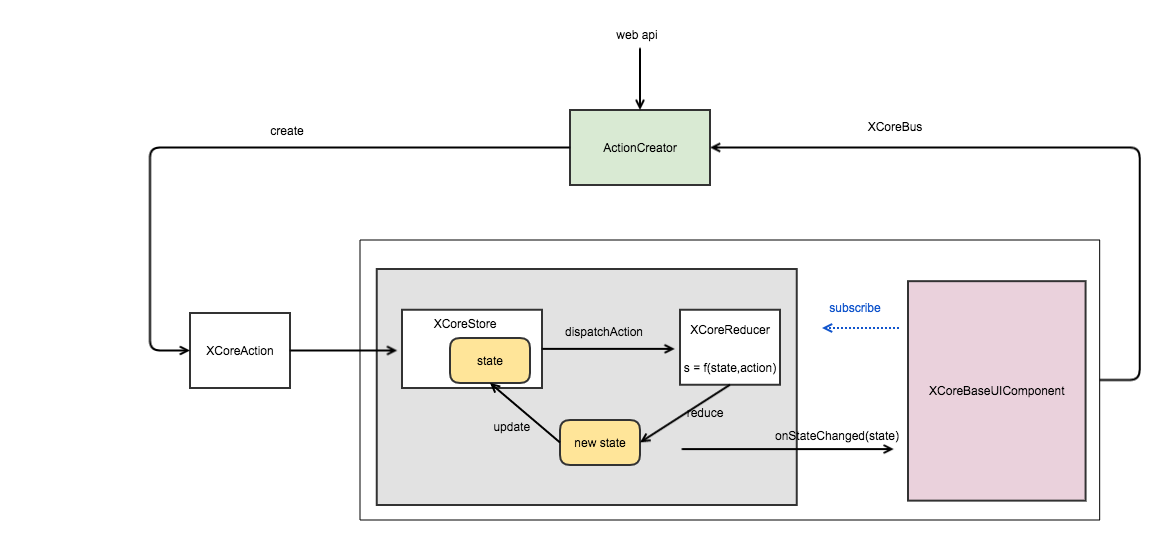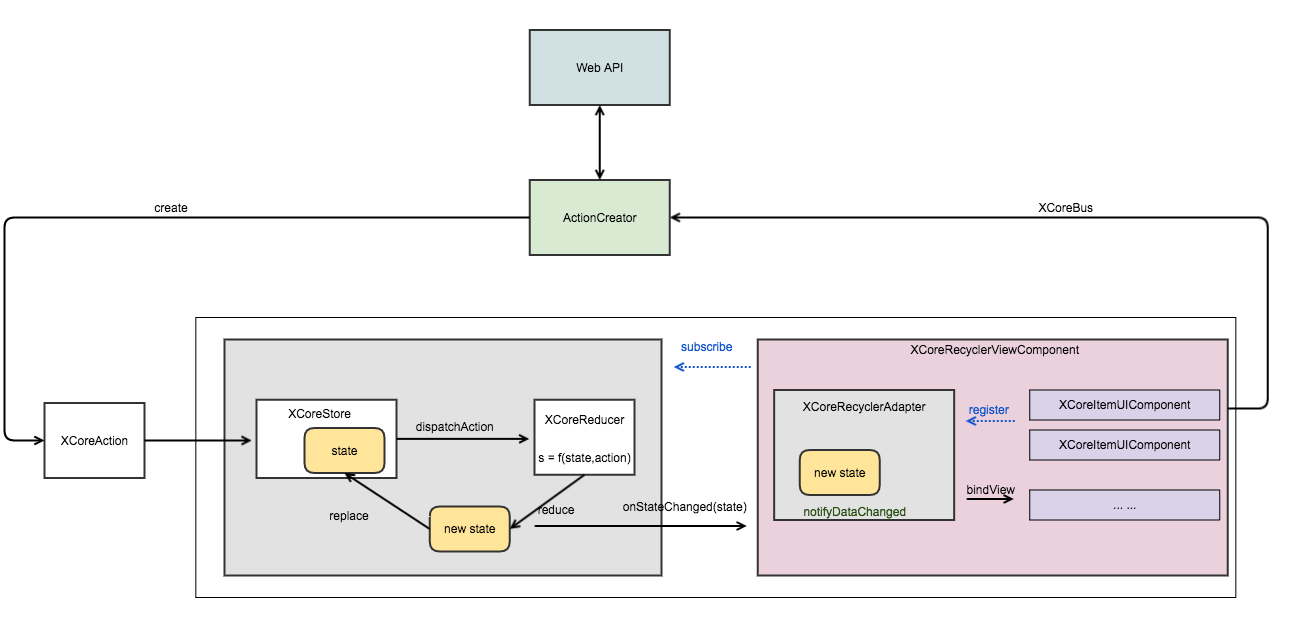XCoreRedux框架:Android UI組件化與Redux實踐
@author: 莫川 https://github.com/nuptboyzhb/
XCoreRedux源碼+Demo:https://github.com/nuptboyzhb/XCoreRedux
使用android studio打開該項目。
目錄結構
- demo
基于xcore框架寫的一個小demo - xcore
XCoreRedux核心代碼庫 - pics
文檔的pic資源
前言
- Android開發當中的Code Architecture思考
最近看了很多前端的框架,React、Flux、Redux等,React和Redux都是前端比較流行的框架。而android方面,Google官方貌似不太Care此事,業內也沒有公認的優秀Architecture。與前端類似,在Android開發中,同樣也面臨著復雜的數據state管理的問題。在理解Store、Reducer和Action的基礎上,最終,基于Redux+React的思想,提出了一個基于Android平臺Redux框架,我給它起名叫作:XCoreRedux。本倉庫就是XCoreRedux+UIComponent框架的實現。它表達的是一種思想,希望大家能夠提出更好的意見。
XCoreRedux框架介紹
與前端的Redux框架類似,XCoreRedux框架的圖示如下:
Action
Action 是把數據傳到 store 的有效載體。它是store的唯一數據來源。我們一般是通過 store.dispatch()將action傳到store中。Action一般需要兩個參數:type類型和data數據。在XCoreRedux框架下,我們定義Action如下:
public class XCoreAction {//Action的類型public final String type;//Action攜帶的value,可為空public final Object value;public XCoreAction(String type, Object value) {this.type = type;this.value = value;}public XCoreAction(String type) {this(type, null);}@Overridepublic boolean equals(Object object) {...}@Overridepublic int hashCode() {...}
}為了統一的管理Action,你可以實現一個ActionCreator,比如,demo中創建了一個聯系人業務的Creator:
/*** @version mochuan.zhb on 16/9/28.* @Author Zheng Haibo* @Blog github.com/nuptboyzhb* @Company Alibaba Group* @Description 聯系人 ActionCreator*/
public class ContactsActionCreator {public static final String ADD_ITEM = "AddContacts";public static final String ADD_TITLE = "addCategory";public static final String DELETE_LAST = "deleteLast";public static final String CHECK_BOX = "contactsCheck";public static XCoreAction addContacts(Contacts contacts) {return new XCoreAction(ADD_ITEM, contacts);}public static XCoreAction addCategory(Title title) {return new XCoreAction(ADD_TITLE, title);}public static XCoreAction deleteLast() {return new XCoreAction(DELETE_LAST);}public static XCoreAction checkBoxClick(ContactsWrapper contactsWrapper) {return new XCoreAction(CHECK_BOX, contactsWrapper);}
}
Action的概念比較好理解,下面我們看一下Reducer
Reducer
reducer的字面意思就是“減速器”。Action描述了事件,Reducer是決定如何根據Action更新狀態(state),而這正是reducer要做的事情。Reducer的接口定義如下:
public interface IXCoreReducer<State> {State reduce(State state, XCoreAction xcoreAction);
}就是根據輸入的Action和當前的state,處理得到新的state。
(previousState, action) => newState
說的更直白一點,Reducer就是一些列 純函數 的集合。如Demo中的項目所示:
public class ContactsReducer implements IXCoreReducer<List<XCoreRecyclerAdapter.IDataWrapper>> {/*** 添加聯系人** @param contactsWrappers* @param contacts* @return*/private List<XCoreRecyclerAdapter.IDataWrapper> addOneContacts(List<XCoreRecyclerAdapter.IDataWrapper> contactsWrappers, Contacts contacts) {......return wrappers;}/*** 添加標題** @param contactsWrappers* @param value* @return*/private List<XCoreRecyclerAdapter.IDataWrapper> addOneTitle(List<XCoreRecyclerAdapter.IDataWrapper> contactsWrappers, Title value) {......return wrappers;}/*** 刪除最后一個** @param contactsWrappers* @return*/private List<XCoreRecyclerAdapter.IDataWrapper> deleteLast(List<XCoreRecyclerAdapter.IDataWrapper> contactsWrappers) {List<XCoreRecyclerAdapter.IDataWrapper> wrappers = new ArrayList<>(contactsWrappers);if (wrappers.size() > 0) {wrappers.remove(wrappers.size() - 1);}return wrappers;}/*** 設置選擇狀態** @param contactsWrappers* @param value* @return*/private List<XCoreRecyclerAdapter.IDataWrapper> changeCheckBoxStatus(List<XCoreRecyclerAdapter.IDataWrapper> contactsWrappers, ContactsWrapper value) {value.isChecked = !value.isChecked;return contactsWrappers;}@Overridepublic List<XCoreRecyclerAdapter.IDataWrapper> reduce(List<XCoreRecyclerAdapter.IDataWrapper> contactsWrappers, XCoreAction xcoreAction) {switch (xcoreAction.type) {case ContactsActionCreator.ADD_ITEM:return addOneContacts(contactsWrappers, (Contacts) xcoreAction.value);case ContactsActionCreator.ADD_TITLE:return addOneTitle(contactsWrappers, (Title) xcoreAction.value);case ContactsActionCreator.DELETE_LAST:return deleteLast(contactsWrappers);case ContactsActionCreator.CHECK_BOX:return changeCheckBoxStatus(contactsWrappers, (ContactsWrapper) xcoreAction.value);...}return contactsWrappers;}
}
通過上面的Reducer實現,我們可以看出,Reducer就是一些列函數的集合,其中一個關鍵函數reduce,它按照action的不同type執行不同的方法處理。
Store
store字面意思是存儲。在Redux框架下,Store和DataBase,File沒有關系,它可不是持久化存儲的意思。Store是負責管理數據源的狀態,負責把Action和Reducer聯系到一起。Store的職責為:
- 1.保存數據源的當前狀態state
- 2.對外提供dispatch方法,更新state
- 3.通過subscribe注冊監聽器,當state變化時,通知觀察者
- 4.提供getState方法,獲取當前的state
Store的Java實現:
public class XCoreStore<State> {private final IXCoreReducer<State> mIXCoreReducer;//數據處理器-reducerprivate final List<IStateChangeListener<State>> listeners = new ArrayList<>();//觀察者private volatile State state;//Store存儲的數據private XCoreStore(IXCoreReducer<State> mIXCoreReducer, State state) {this.mIXCoreReducer = mIXCoreReducer;this.state = state;}/*** 內部dispatch** @param xCoreAction*/private void dispatchAction(final XCoreAction xCoreAction) throws Throwable {synchronized (this) {state = mIXCoreReducer.reduce(state, xCoreAction);}for (IStateChangeListener<State> listener : listeners) {listener.onStateChanged(state);}}/*** 創建Store** @param reducer* @param initialState* @param <S>* @return*/public static <S> XCoreStore<S> create(IXCoreReducer<S> reducer, S initialState) {return new XCoreStore<>(reducer, initialState);}public State getState() {return state;}public void dispatch(final XCoreAction action) {try {dispatchAction(action);} catch (Throwable e) {e.printStackTrace();}}/*** 注冊接口;添加觀察者,當state改變時,通知觀察者** @param listener*/public void subscribe(final IStateChangeListener<State> listener) {listeners.add(listener);}/*** 注銷** @param listener*/public void unSubscribe(final IStateChangeListener<State> listener) {listeners.remove(listener);}/*** 狀態改變的回調接口** @param <S> 狀態*/public interface IStateChangeListener<S> {void onStateChanged(S state);}}
在Android中,一個Redux頁面(Fragment或者Activity) 只有一個單一的 store。當需要拆分數據處理邏輯時,應該使用 reducer組合,而不是創建多個Store。
搭配UIComponent
與前端的Redux搭配React類似,XCoreRedux搭配UIComponent。
UI組件化(UIComponent)
在前段的React框架下,我們常常聽說組件的概念:‘UI組件’。那么什么是UI組件呢?以下圖為例:
紅色的區域為“普通組件”,綠色的區域為兩種不同類型的“Item組件”。因此,在UIComponent里,組件分兩種:普通組件和item組件(或稱為cell組件)。
普通組件
- 單組件,比如一個自定義的Widget,就是一樣View。比如自定義的CircleImageView等。
- 容器組件,由ViewGroup派生出的組件。有FrameLayout、LinearLayout、RelativeLayout等。還有些常見的列表組件,比如ListView或者RecyclerView的組件等。
普通組件在XCore中是以FrameLayout的形式封裝的,編寫一個普通組件只需要實現如下方法:
-
1.public int getLayoutResId()
返回組件的布局資源Id -
2.public void onViewCreated(View view)
View初始化 -
3.實現XCoreStore中的IStateChangeListener接口,在onStateChanged中做數據綁定
為了使UI組件能夠與Store進行關聯,UI組件可以實現IStateChangeListener接口,然后作為觀察者,觀察Store的state變化。然后在onStateChanged方法中做數據綁定。
Item組件(Cell組件)
對于前端來說,item組件和普通組件并沒有什么不同。但是對于Android或者iOS而言,item組件和普通組件是有本質區別的。以ReyclerView為例,Item組件在同一種類型下是會復用的。在XCoreRedux框架中,定義Item組件,需要繼承自XCoreItemUIComponent,它本身并不是一個View。它只需要實現的方法有:
- View onCreateView(LayoutInflater inflater,ViewGroup container);
與Fragment的onCreateView類似,它負責創建item的布局View - void onViewCreated(View view);
與Fragment的onViewCreated類似,在此寫View的初始化 - public String getViewType();
Item組件對于數據源的類型 - public void bindView(IXCoreComponent coreComponent,
XCoreRecyclerAdapter coreRecyclerAdapter,
XCoreRecyclerAdapter.IDataWrapper data,
int pos);
數據綁定,當Adapter調用bindViewHolder時,會回調bindView方法。
Item組件需要通過Adapter,與對應的列表組件聯系起來。針對Android常用的RecyclerView,XCoreRedux提供了插件式的通用XCoreRecyclerAdapter。
含列表組件下的XCoreRedux框架圖
與之前的不同之處在于,這里把整個列表封裝成一個列表組件,對外提供注冊Item,比如XCoreRecyclerViewComponent組件源碼。
public class XCoreRecyclerViewComponent extends XCoreUIBaseComponent implements XCoreStore.IStateChangeListener<List<XCoreRecyclerAdapter.IDataWrapper>> {private SwipeRefreshLayout mSwipeRefreshLayout;private RecyclerView mRecyclerView;private RecyclerView.LayoutManager mLayoutManager;private XCoreRecyclerAdapter mXCoreRecyclerAdapter;public XCoreRecyclerViewComponent(Context context) {super(context);}public XCoreRecyclerViewComponent(Context context, AttributeSet attrs) {super(context, attrs);}public XCoreRecyclerViewComponent(Context context, AttributeSet attrs, int defStyleAttr) {super(context, attrs, defStyleAttr);}@Overridepublic final int getLayoutResId() {return R.layout.xcore_recyclerview_component;}@Overridepublic void onViewCreated(View view) {//初始化ViewmSwipeRefreshLayout = (SwipeRefreshLayout) findViewById(R.id.xcore_refresh_layout);mSwipeRefreshLayout.setEnabled(false);mRecyclerView = (RecyclerView) findViewById(R.id.xcore_rv);//初始化RecyclerViewmLayoutManager = new LinearLayoutManager(getContext());mRecyclerView.setLayoutManager(mLayoutManager);mXCoreRecyclerAdapter = new XCoreRecyclerAdapter(this);mRecyclerView.setAdapter(mXCoreRecyclerAdapter);}public SwipeRefreshLayout getSwipeRefreshLayout() {return mSwipeRefreshLayout;}public RecyclerView getRecyclerView() {return mRecyclerView;}public RecyclerView.LayoutManager getLayoutManager() {return mLayoutManager;}public XCoreRecyclerAdapter getXCoreRecyclerAdapter() {return mXCoreRecyclerAdapter;}/*** 當狀態發生變化時,自動通知** @param status*/@Overridepublic void onStateChanged(List<XCoreRecyclerAdapter.IDataWrapper> status) {mXCoreRecyclerAdapter.setDataSet(status);mXCoreRecyclerAdapter.notifyDataSetChanged();}/*** 對外提供item組件的注冊** @param xCoreItemUIComponent* @return*/public XCoreRecyclerViewComponent registerItemComponent(XCoreItemUIComponent xCoreItemUIComponent) {mXCoreRecyclerAdapter.registerItemUIComponent(xCoreItemUIComponent);return this;}public void setRefreshEnable(boolean enable) {mSwipeRefreshLayout.setEnabled(enable);}
}我們在使用該組件時,只需要:
1.在XML中添加組件
<?xml version="1.0" encoding="utf-8"?>
<LinearLayout xmlns:android="http://schemas.android.com/apk/res/android"android:layout_width="match_parent"android:layout_height="match_parent"android:orientation="vertical"><!-- 頭部組件--><com.example.haibozheng.myapplication.components.container.HeaderComponentandroid:id="@+id/recycler_view_header_component"android:layout_width="match_parent"android:layout_height="wrap_content" /><!-- 列表組件--><com.github.nuptboyzhb.xcore.components.impl.XCoreRecyclerViewComponentandroid:id="@+id/recycler_view_component"android:layout_width="match_parent"android:layout_height="match_parent" />
</LinearLayout>
2.初始化
...//創建數據源的storemContactsListXCoreStore = XCoreStore.create(new ContactsReducer(), new ArrayList<XCoreRecyclerAdapter.IDataWrapper>());//創建RecyclerView的UI組件mXCoreRecyclerViewComponent = (XCoreRecyclerViewComponent) findViewById(R.id.recycler_view_component);//注冊item組件模板mXCoreRecyclerViewComponent.registerItemComponent(new TextItemComponent()).registerItemComponent(new ImageItemComponent());//創建頭部組件mHeaderComponent = (HeaderComponent) findViewById(R.id.recycler_view_header_component);//添加觀察者mContactsListXCoreStore.subscribe(mXCoreRecyclerViewComponent);mContactsListXCoreStore.subscribe(mHeaderComponent);...組件之間通信
Item組件與列表組件及普通組件之間的通信。在本Demo中使用的EventBus是輕量級的otto。每一個繼承自XCoreUIBaseComponent的組件,都已經在onCreate和onDestroy中分別進行了注冊和反注冊。使用時,只需要使用@Subscribe 注解來指定訂閱方法。因此,在任意地方都可以調用:
XCoreBus.getInstance().post(action);小優化
對于數據綁定方面,做了兩個優化:
1.把數據通過Wrapper包裝
2.使用UIBinderHelper做流式綁定,比如:
public class ImageItemComponent extends XCoreItemUIComponent implements View.OnClickListener {private UIBinderHelperImpl mUIBinderHelperImpl;...@Overridepublic void bindView(IXCoreComponent coreComponent,XCoreRecyclerAdapter coreRecyclerAdapter,XCoreRecyclerAdapter.IDataWrapper data,int pos) {mContactsWrapper = (ContactsWrapper) data;mUIBinderHelperImpl.from(R.id.item_content_tv).setText(mContactsWrapper.bindContentText()).from(R.id.item_pic_iv).setImageUrl(mContactsWrapper.getAvatarUrl()).from(R.id.item_title_tv).setText(mContactsWrapper.bindItemTitle()).from(R.id.checkbox).setButtonDrawable(mContactsWrapper.isChecked ? R.mipmap.checkbox_checked : R.mipmap.checkbox_normal).setOnClickListener(this);}...
}后續
- 1.異步
- 2.Middleware中間件
- 3.與Rx結合
參考文獻
- Redux中文文檔
- Flux and Android
- AndroidFlux一覽







![BZOJ 1854: [Scoi2010]游戲( 二分圖最大匹配 )](http://pic.xiahunao.cn/BZOJ 1854: [Scoi2010]游戲( 二分圖最大匹配 ))
)
)




)







